 W
WEleutherodactylus is a genus of frogs in the family Eleutherodactylidae. Many of the 200 species of the genus are commonly known as "rain frogs" or "robber frogs", due to their sharp, high-pitched, insect-like calls.
 W
WEleutherodactylus albipes is a species of frog in the family Eleutherodactylidae endemic to Cuba. Its natural habitat is subtropical or tropical moist montane forest. It is threatened by habitat loss.
 W
WEleutherodactylus angustidigitorum is a species of frog in the family Eleutherodactylidae. It is endemic to Mexico and is known from Michoacán and southern Jalisco (Tuxpan). Common names Patzcuaro peeping frog and Patzcuaro stream frog have been coined for it.
 W
WThe Antilles coqui, commonly known as the Montserrat whistling frog, Barbados whistling frog, or the Lesser Antillean whistling frog, is a species of frog in the family Eleutherodactylidae found in Bermuda, the Caribbean and northern South America. Its natural habitats are subtropical or tropical moist lowland forest, subtropical or tropical moist montane forest, subtropical or tropical moist shrubland, subtropical or tropical dry lowland grassland, arable land, pastureland, plantations, rural gardens, urban areas, and heavily degraded former forests.
 W
WEleutherodactylus atkinsi is a species of frog in the family Eleutherodactylidae endemic to Cuba. Its natural habitats are dry forests, moist forests, moist shrubland, flooded grasslands and savannas, swamps, caves, arable land, pastures, plantations, rural gardens, urban areas, heavily degraded former forests, irrigated land, seasonally flooded agricultural land, and canals and ditches.
 W
WEleutherodactylus auriculatus is a species of frog in the family Eleutherodactylidae endemic to Cuba. It is a widespread species that also occurs on the Isla de Juventud. It is found from sea level to 1,300 m (4,300 ft) asl.
 W
WThe bronze coqui, Richmond's coqui, coquí caoba, or coquí de Richmond is a species of frog in the family Eleutherodactylidae. The specific epithet, richmondi, is dedicated to Dr. Charles W. Richmond.
 W
WThe common coquí or coquí is a species of frog endemic to Puerto Rico belonging to the family Eleutherodactylidae. The species is named for the loud call the males make at night. This sound serves two purposes. "CO" serves to repel males and establish territory while the "KEE" serves to attract females. Since the auditory systems of males and females respond preferentially to different notes of the male call, this is an example of a sex difference in a sensory system. The common coquí is a very important aspect of Puerto Rican culture, and it has become an unofficial territorial symbol of Puerto Rico.
 W
WThe cricket coqui, green coqui, or coqui grillo is a species of frog in the family Eleutherodactylidae endemic to Puerto Rico. Its natural habitats are subtropical or tropical moist lowland forest and subtropical or tropical moist montane forest.
 W
WEleutherodactylus cubanus is a species of frog in the family Eleutherodactylidae found in Cuba. Its natural habitats are tropical moist montane forest. It is threatened by habitat loss.
 W
WEleutherodactylus cuneatus is a species of frog in the family Eleutherodactylidae endemic to Cuba. Its natural habitats are subtropical or tropical moist lowland forest, subtropical or tropical moist montane forest, subtropical or tropical moist shrubland, subtropical or tropical seasonally wet or flooded lowland grassland, rivers, arable land, pastureland, plantations, rural gardens, urban areas, heavily degraded former forest, and seasonally flooded agricultural land.
 W
WEleutherodactylus cystignathoides, also known as the Rio Grande chirping frog, Mexican chirping frog, or lowland chirping frog, is a small eleutherodactylid frog. It is found from the southern United States in Texas, and in the northeastern Mexico in the states of Nuevo León, Tamaulipas, San Luis Potosí, Hidalgo, and Veracruz. Its range in Texas has expanded because of transport in potted plants, and there is also a likely introduced population in Louisiana.
 W
WEleutherodactylus dilatus is a species of frog in the family Eleutherodactylidae. It is endemic to Mexico and restricted to the Chilpancingo region of the Sierra Madre del Sur in central Guerrero. Its common name is Guerreran peeping frog.
 W
WEleutherodactylus dimidiatus is a rare species of frog in the family Eleutherodactylidae endemic to Cuba. Its natural habitats are subtropical or tropical moist lowland forest and subtropical or tropical moist montane forest. It is threatened by habitat loss.
 W
WThe dwarf coqui or elfin coqui is a species of frog endemic to Puerto Rico. It is placed in the subgenus Eleutherodactylus.
 W
WEleutherodactylus is a genus of frogs in the family Eleutherodactylidae. Many of the 200 species of the genus are commonly known as "rain frogs" or "robber frogs", due to their sharp, high-pitched, insect-like calls.
 W
WEleutherodactylus is a genus of frogs in the family Eleutherodactylidae. Many of the 200 species of the genus are commonly known as "rain frogs" or "robber frogs", due to their sharp, high-pitched, insect-like calls.
 W
WEneida's coquí is a species of coquí, a small variety of frog endemic to the main island of Puerto Rico and its archipelago. Known as coquí de Eneida in Puerto Rico, this amphibian is mainly terrestrial. Its average adult size is from 1.0 to 1.2 inches. It has a number of small warts located across its back and eyelids. Its main color is a light tone of greenish or grayish brown with a yellow tint on its underbelly. They often have a pair of light colored concave lines located on their backs. Their eyes are golden or green colored, generally dark colored with black venal reticulation. Its habitat is located in mountains that are 1,000 to 3,000 feet above sea level. This species seems to have suffered a population reduction, in the process disappearing from areas formerly considered its natural habitat. The reason behind this reduction is under study, and Eneida's coquí has been designated an endangered species until the cause is discovered. This population decrease is not considered to be linked with the loss of its habitat, which has prevented the protection of its habitat.
 W
WEleutherodactylus etheridgei is a species of frog in the family Eleutherodactylidae endemic to Cuba. Its natural habitats are subtropical or tropical moist lowland forest and rocky areas. It is threatened by habitat loss.
 W
WEleutherodactylus glandulifer is a species of frog in the family Eleutherodactylidae endemic to the Massif de la Hotte, Haiti. Its natural habitat is closed-canopy forest, usually near streams. Its most distinctive feature are its striking blue sapphire-colored eyes—a highly unusual trait among amphibians.
 W
WThe golden coquí is a rare species of frog endemic to Puerto Rico.
 W
WEleutherodactylus grandis, also known as the great peeping frog, is a species of frog in the family Eleutherodactylidae. It is endemic to Mexico and only known from near its type locality on the lava fields of Xitle volcano, in the southern part of the Mexico City federal district. Its natural habitat is shrubland. It is threatened by habitat loss caused by spreading of Mexico City. Little suitable habitat remains, and the species is thought to be restricted to the Pedregal Reserve.
 W
WThe grass coqui or coqui de las hierbas is a species of frog in the family Eleutherodactylidae, endemic to Puerto Rico. Its natural habitats are subtropical or tropical moist lowland forest, subtropical or tropical moist montane forest, subtropical or tropical seasonally wet or flooded lowland grassland, plantations, rural gardens, and heavily degraded former forest. It is threatened by habitat loss.
 W
WThe greenhouse frog is a species of frog in the family Eleutherodactylidae, native to Cuba, the Bahamas, and the Cayman Islands, and it has been introduced to other areas, such as Florida, Hawaii, Guam, Hong Kong and Shenzhen.
 W
WEleutherodactylus guanahacabibes is a species of frogs in the family Eleutherodactylidae endemic to Cuba, and is named for the Guanahacabibes Peninsula. Its natural habitats are subtropical or tropical moist lowland forest, rocky areas, and caves. It is threatened by habitat loss.
 W
WEleutherodactylus gundlachi is a species of frog in the family Eleutherodactylidae. It is endemic to southeastern Cuba. The specific name gundlachi honors Johannes Christoph Gundlach, a German zoologist. Common names Turquino spiny frog and Gundlach's robber frog have been coined for it.
 W
WThe spotted chirping frog or Mexican cliff frog, Eleutherodactylus guttilatus, is a species of small Eleutherodactylid frog native to the southern United States and Mexico. They are found in moderate elevation ranges of the Sierra Madre Oriental mountain range, from the Davis Mountains in west Texas south to the Mexican states of Coahuila, Nuevo León, San Luis Potosí, Durango and Guanajuato. They grow from 0.75 to 1.25 inches in length, and are easily mistaken for other Eleutherodactylus species, with which they share range. This has led to some confusion in its taxonomic classification.
 W
WHedrick's coqui, the treehole coqui, or coqui de Hedrick is a species of frog in the family Eleutherodactylidae endemic to Puerto Rico. Its natural habitats are subtropical or tropical moist lowland forest and subtropical or tropical moist montane forest.
 W
WEleutherodactylus intermedius is a species of frog in the family Eleutherodactylidae endemic to eastern Cuba where it is known from the Sierra Maestra and Sierra del Cobre. Its common name is Pico Turquino robber frog, in reference to its type locality.
 W
WEleutherodactylus ionthus is a species of frog in the family Eleutherodactylidae endemic to Cuba. Its natural habitats are subtropical or tropical moist lowland forest and subtropical or tropical moist montane forest. It is threatened by habitat loss.
 W
WEleutherodactylus juanariveroi, the Puerto Rican wetland frog or, is an endangered species of coqui, a frog species, endemic to Puerto Rico. It was discovered in 2005 by Neftalí Rios, and was named after Puerto Rican herpetologist Juan A. Rivero, in honor of his contributions to Puerto Rican herpetology. It is only found in the old Naval Base of Sábana Seca in Toa Baja, Puerto Rico. It is characterized by a high-frequency, chip-like sound, a light-brown skin color, and a strip between the eyes. It is the smallest species of coqui.
 W
WThe web-footed coqui, stream coqui, Puerto Rican stream frog, or Karl's robber frog, Eleutherodactylus karlschmidti, is a possibly extinct Puerto Rican frog species in the family Eleutherodactylidae. It was first described by Chapman Grant in 1931, and was named after herpetologist Karl Patterson Schmidt. It is the largest Eleutherodactylus species of Puerto Rico.
 W
WEleutherodactylus longipes is a species of frog in the family Eleutherodactylidae. It is endemic to Mexico and occurs on the Sierra Madre Oriental between central Nuevo León and adjacent Coahuila in the north and northern Hidalgo in the south. It is also known as the long-footed chirping frog and longfoot robber frog, among other names.
 W
WEleutherodactylus luteolus is a species of frog in the family Eleutherodactylidae endemic to Jamaica. Its natural habitat is subtropical or tropical moist lowland forest. It is threatened by habitat loss.
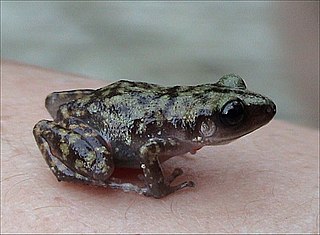 W
WEleutherodactylus marnockii, the cliff chirping frog, is a small eleutherodactylid frog found in central and western Texas, the United States, and in Coahuila, northern Mexico. It is also known as the cliff frog and Marnock's frog.
 W
WEleutherodactylus martinicensis is a species of frog in the family Eleutherodactylidae found in Antigua and Barbuda, Dominica, Guadeloupe, Martinique, and Saint Lucia. Its natural habitats are subtropical or tropical dry forests, subtropical or tropical moist lowland forests, subtropical or tropical moist montane forests, subtropical or tropical moist shrubland, subtropical or tropical seasonally wet or flooded lowland grassland, arable land, pastureland, plantations, rural gardens, urban areas, and heavily degraded former forests. It is threatened by habitat loss.
 W
WThe melodius coqui or coquí melodioso is a frog species in the family Eleutherodactylidae endemic to Puerto Rico. Its natural habitats are subtropical or tropical moist lowland forest and subtropical or tropical moist montane forest. It is threatened by habitat loss.
 W
WEleutherodactylus minutus is a species of frog in the family Eleutherodactylidae endemic to the Cordillera Central, Dominican Republic, at elevations of 879–2,300 m (2,884–7,546 ft) asl. Its common name is tiny robber frog. Its natural habitats are mesic upland broadleaf or pine forests. In suitable habitat it is moderately common. It is threatened by habitat loss caused by agriculture.
 W
WThe Mona coqui,, Eleutherodactylus monensis, is a species of frog in the family Eleutherodactylidae endemic to Mona, Puerto Rico. Its natural habitats are subtropical or tropical dry forest and subtropical or tropical dry shrubland.
 W
WThe Monte Iberia eleuth, also known as the Monte Iberia dwarf frog, is a species of eleutherodactylid frog. It is critically endangered and endemic to rainforest in a small part of easternmost Cuba. It is the smallest frog in the Northern Hemisphere and the third smallest frog in the world, at about 10 mm (0.4 in) in snout–to–vent length.
 W
WEleutherodactylus orientalis, the Oriental robber frog or Baracoa dwarf frog, is a species of frog in the family Eleutherodactylidae. It is endemic to the vicinity of El Yunque, Baracoa, in easternmost Cuba. Although locally common, it requires undisturbed moist forest and has a tiny range, making it critically endangered from habitat loss and degradation.
 W
WEleutherodactylus oxyrhyncus is a species of frog in the family Eleutherodactylidae. It is endemic to Hispaniola and known from the Massif de la Hotte and Massif de la Selle, occurring in both the Dominican Republic and Haiti. The common name is rednose robber frog.
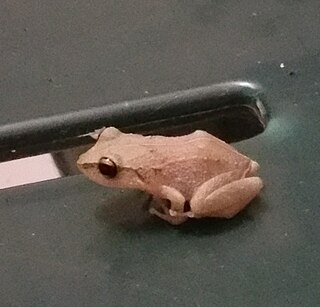 W
WEleutherodactylus pinchoni is a species of frog in the family Eleutherodactylidae. It is endemic to Guadeloupe and known from the Basse-Terre. Common name Grand Cafe robber frog has been coined for it.
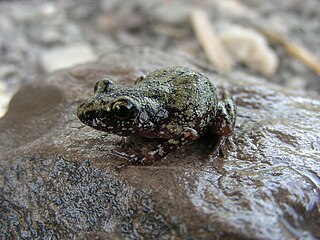 W
WEleutherodactylus pipilans is a species of frog in the family Eleutherodactylidae. It is found in southern and southeastern Mexico and southwestern Guatemala.
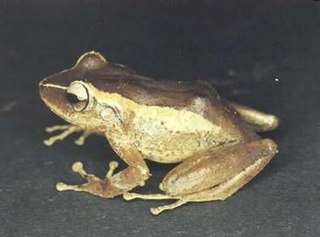 W
WEleutherodactylus portoricensis is a frog native to Puerto Rico that belongs to the family Eleutherodactylidae. Its vernacular English names are upland coqui, mountain coqui, and Puerto Rican robber frog. It is found in the Toro Negro State Forest and other similar mountainous regions.
 W
WThe Puerto Rican rock frog, Eleutherodactylus cooki, also known as the Puerto Rican cave-dwelling frog or rock coqui, and locally as coquí guajón, or guajón for brevity, is a threatened frog species from the coqui genus. This unique species of tropical frogs dwells primarily in crevices and grottos in the Cuchilla de Panduras mountain range in southeastern Puerto Rico. The native name guajón is derived from its habitat, guajonales, which are caves formed by rock formations between huge stones. Despite being the state animal and considered emblematic of the region, of the 17 species of coquí, three are believed to be extinct and the rest are rare and declining in numbers. The Puerto Rican rock frog is extremely restricted in geographical distribution. The frog is threatened due to deforestation, agricultural, rural, and industrial development, and the associated infrastructure. It is sometimes called the “demon of Puerto Rico" because of its eerie call and phantom-like appearance. The species was first described by American herpetologist, Chapman Grant in 1932.
 W
WThe red-eyed coqui, churi, coqui churi, or coqui de las Antillas is a species of frog in the family Eleutherodactylidae that is found in Puerto Rico, the British and U.S. Virgin Islands, and introduced to Panama. Although there are many similar species that are endemic to these tropical locations, its unique physical, habitual, and behavioral characteristics distinguish it from other members of the genus Eleutherodactylus. This genus contains around 185 species that are located in the southern United States, Central America, South America, and the Caribbean, with 16 different species endemic to Puerto Rico. The red-eyed coqui was not brought into Panama City from its native habitats until the late 1960s. There it became established in urban parks before it began to colonize outside the city in the 1980s. In Puerto Rico, the largest island inhabited by the red-eyed coqui, it is found up to 1,200 meters above sea level. It is often compared to the common coqui, Puerto Rico's unofficial territorial symbol, but upon a closer ecological look, the red-eyed coqui has many differences.
 W
WEleutherodactylus ricordii is a species of frog in the family Eleutherodactylidae endemic to Cuba. Its natural habitats are subtropical or tropical moist lowland forest, subtropical or tropical moist montane forest, and rocky areas. It is threatened by habitat loss.
 W
WEleutherodactylus ruthae is a species of frog in the family Eleutherodactylidae. It is endemic to Hispaniola and known from scattered locations in both Haiti and the Dominican Republic. It was described by Gladwyn Kingsley Noble, who named it in honour of his wife, Ruth Crosby Noble; she also first discovered the species. It might represent more than one species. Eleutherodactylus aporostegus, Eleutherodactylus bothroboans, Eleutherodactylus tychaethrous were first described as subspecies of Eleutherodactylus ruthae, but have later been elevated to full species status.
 W
WEleutherodactylus simulans is a species of frog in the family Eleutherodactylidae endemic to Cuba. Its natural habitats are subtropical or tropical moist lowland forest and rivers. It is threatened by habitat loss.
 W
WEleutherodactylus thorectes is a species of frog in the family Eleutherodactylidae. It is endemic to Haiti and known from the Massif de la Hotte at high elevations. Specifically, it is known from Pic Macaya and Pic Formon at elevations of 1,700–2,340 m (5,580–7,680 ft) asl. Its natural habitats are closed pine montane forest and cloud forest with shrubs, tree ferns, bromeliads, and climbing bamboo. With a snout-vent length of 12–15 mm, this slightly arboreal species is one of the smallest of the world's frogs. It is threatened by habitat loss caused by charcoal logging and agriculture. It is known from the Pic Macaya National Park, but habitat degradation is occurring in the park too.
 W
WEleutherodactylus turquinensis is a species of frog in the family Eleutherodactylidae endemic to Cuba. Its natural habitats are subtropical or tropical moist lowland forest, subtropical or tropical moist montane forest, and rivers. It is threatened by habitat loss.
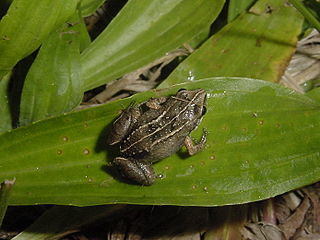 W
WEleutherodactylus varleyi is a species of frog in the family Eleutherodactylidae endemic to Cuba. Its natural habitats are subtropical or tropical moist lowland forest, subtropical or tropical seasonally wet or flooded lowland grassland, arable land, pastureland, plantations, rural gardens, urban areas, and heavily degraded former forest.
 W
WEleutherodactylus verrucipes is a species of frog in the family Eleutherodactylidae. It is endemic to Mexico. Its natural habitats are subtropical or tropical moist lowland forests and subtropical or tropical moist montane forests. It is threatened by habitat loss.
 W
WEleutherodactylus weinlandi is a species of frog in the family Eleutherodactylidae endemic to eastern Hispaniola; it is found in the Dominican Republic and central Haiti. It is a common, terrestrial frog that occurs in a range of mesic habitats: plantations, woods, gardens, ravines, and even trash piles in urban areas.
 W
WThe yellow-striped pygmy eleuth, also known as the yellow-striped dwarf frog, is a species of frog in the family Eleutherodactylidae from closed mesic and xeric forests in Cuba.